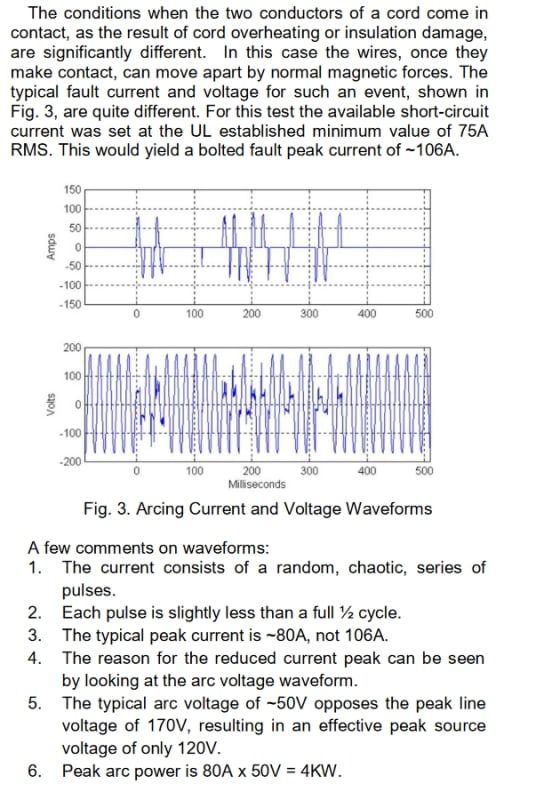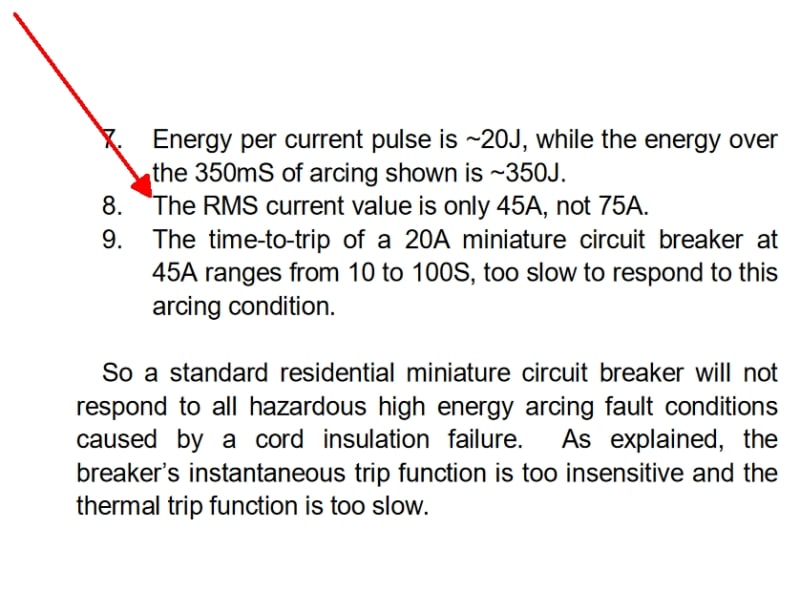Why do AFCIs stop looking for Arc Faults at 75 amps when a frayed cord can arc below that threshold? I thought AFCIs were mainly propelled into the code by the CPSC who feared many fires were attributed to damaged cables.




Follow along with the video below to see how to install our site as a web app on your home screen.
Note: This feature may not be available in some browsers.


UL said:Therefore, provided an available fault current can be guaranteed to exceed the magnetic trip level, breakers can be effective at mitigating arcing faults.
“Evaluation of Run Length and Available Current on Breaker Ability to Mitigate Parallel Arcing Faults”. It has been
argued in front of CMP2 that, in new construction, 500 amp SCC availability at the panel is prevalent. Attached is a
Parks Associates Nationwide survey of SCC availability at the panel. This survey indicates there is a high probability
that the current will be sufficient to trip a circuit breaker when a parallel arc fault occurs. This is a determining factor in
accepting this comment on Proposal 2-68 and this comment provides the data that the panel requested during the
proposal stage..
The equation in the UL report determines that the protection against parallel arcs in the home run provided by a circuit
breaker is affected by a number of variables. However, the two most significant factors in establishing the level of
parallel arc protection in the home run are the instantaneous trip of the circuit breaker and the available short circuit
current at the panel. The information available in the UL report and the Parks study provide a basis for the distribution
of these values. A statistical simulation of the equation in the UL report using the distribution of the circuit breaker
instantaneous trip values and the available short circuit current values reveals that a high level of protection can be
expected for a 50 ft (14 AWG), 70 ft (12AWG) length of home run. In fact, the statistical analysis indicates that under
the least favorable conditions the confidence level for protection of a 50 ft/70 ft home run exceeds 97%. The conclusion
of this statistical analysis closely correlates with the conclusion in the UL report for protection of the home run.
Consequently the additional requirements introduced in Proposal 2-92 are unwarranted, and the Panel should ACCEPT
IN PRINCIPLE IN PART Proposal 2-68 with the modification shown, in place of the action taken on Proposal 2-92.
The following items should be considered:
1. Available SCC is significantly greater than originally believed.
2. The UL report demonstrates a direct relationship of SCC availability to the ability of a circuit breaker to trip under a
parallel arc fault condition.
3. The Parks study data supports parallel arc fault protection of a 50 ft home run as originally calculated by UL.
The revisions to the Informational Notes from what was presented in Proposal 2-68 are to reflect the 2011 NEC®
changes from FPNs to Informational Notes and to reflect Panel action to ACCEPT Proposals 2-93, 2-94 and 2-95.
Background:
The Parts of this Code Cycle’s Proposal 2-68 that are NOT carried forward for Acceptance In Principle are:
• The portion providing a definition for Arc-Fault Circuit Interrupter (AFCI) incorporated in Article 100 of the 2011 Code
in accordance with panel action on Proposal 2-3 (Log #705) during the last Code Cycle
• The partial deletion of Exception No. 1, resulting from wording incorporated into the main portion of 210.12(A) above
based upon new data explained below.
Proposal 2-68 appeared as Comment 2-68 (Log #1755) on Proposal 2-153 in the 2010 Annual Meeting National
Electrical Code Committee Report on Proposals. This comment was held for further study during the processing of the
2011 NATIONAL ELECTRICAL CODE.
This present Comment on Proposal 2-68 from the 2014 Code Cycle Report on Proposals is to support this proposal as
written and to support Proposal 2-153 from the 2011 Code Cycle as written.
Code Proposal 2-153 from the 2011 Code Cycle was written to remove the metal conduit restriction and allow for an
Outlet Branch Circuit AFCI Receptacle in the first outlet. The Parks Associate Study demonstrated the increased safety
benefits that would result in the widespread acceptance of an AFCI Receptacle. Code Making Panel 2 Accepted this
proposal in Principle during the 2011 Code Cycle ROP meeting. CMP 2 put several Comments to this proposal on Hold
during the 2011 Code Cycle ROC meeting.
Note: Supporting material is available for review at NFPA Headquarters.
From the OP said:So a standard residential miniature circuit breaker will not
respond to all hazardous high energy arcing fault conditions
caused by a cord insulation failure.
